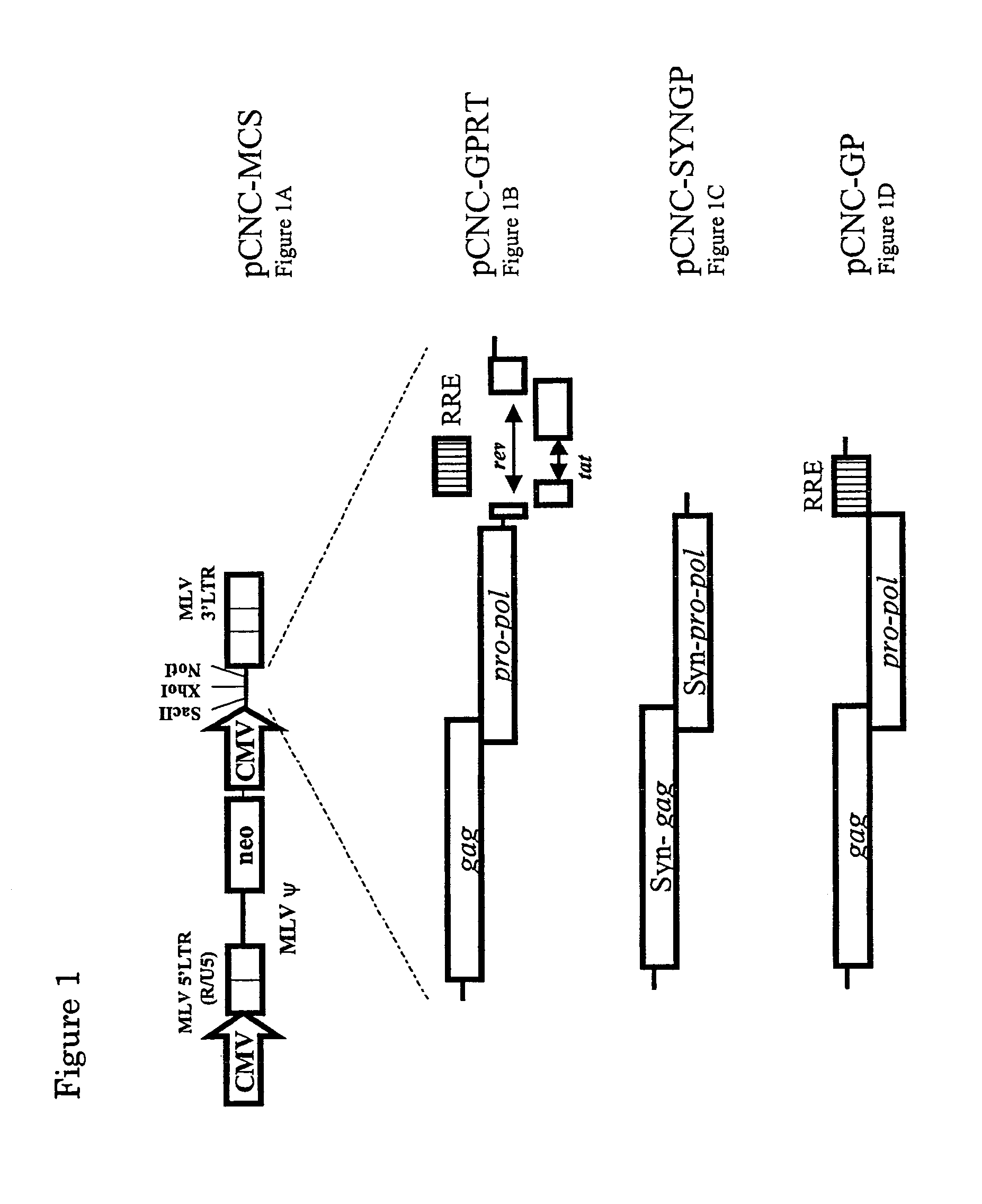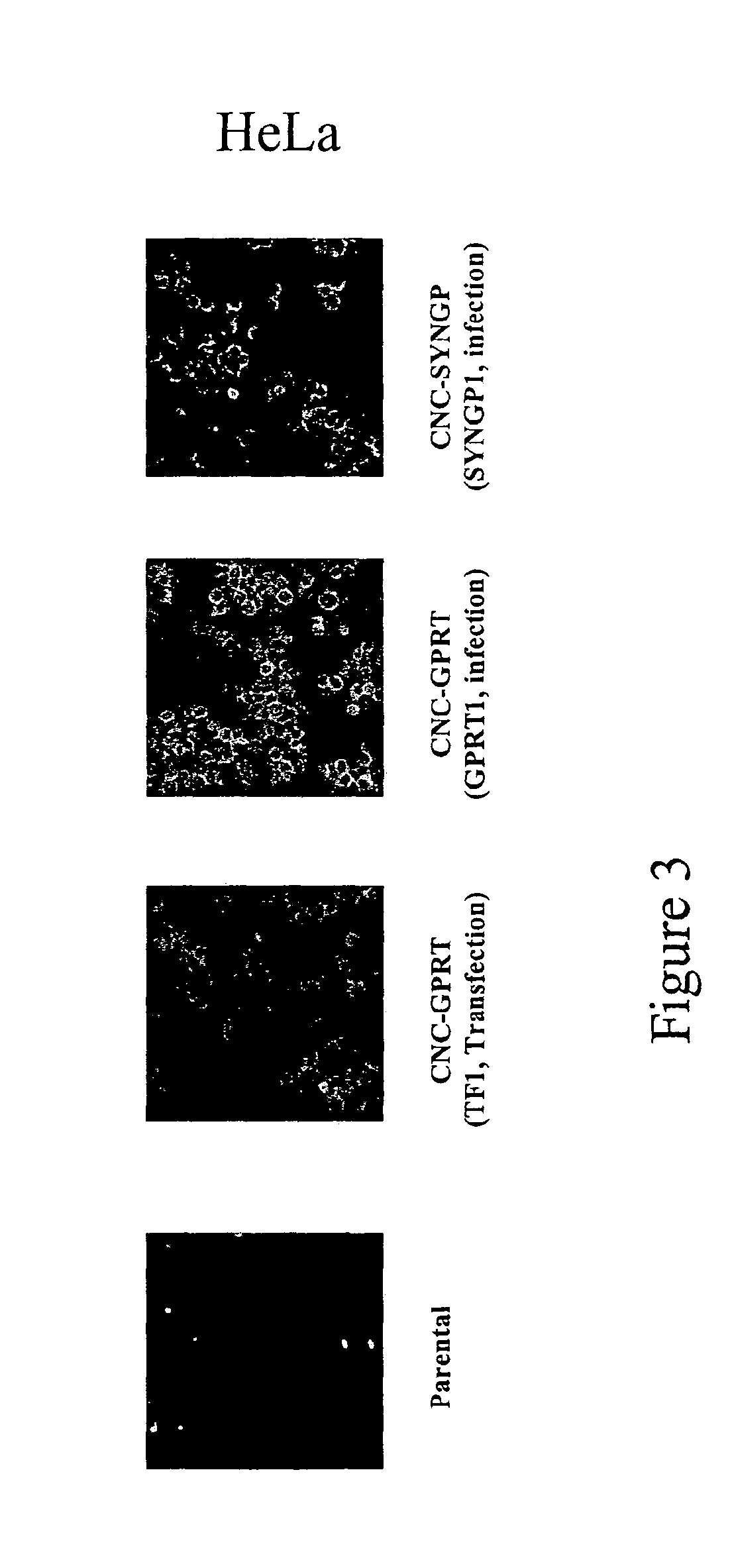Retroviral vector
a technology of vectors and retrovirals, applied in the field of retroviral vectors, can solve the problems of “potentially harmful to a cell and potentially cytotoxic,” and achieve the effects of stable, long-term, and high level of toxicity
- Summary
- Abstract
- Description
- Claims
- Application Information
AI Technical Summary
Benefits of technology
Problems solved by technology
Method used
Image
Examples
example 1
[0256]The vectors pCNC-GPRT (as shown in FIG. 1B) and pCNC-SYNGP) as shown in FIG. 1C) were constructed by inserting HIV-1 sequences from pCMVR8.91 (Zufferey, R., et al. Nat Biotechnol. 15, 871-875 (1997)) or pSYNGP (Kotsopoulo, E., et al. J. Virol. 74, 4839-4852 (2000)), respectively, into the MLV vector—pCNC-MCS, which is shown in FIG. 1A.
[0257]pCNC-GPRT and pCNC-SYNGP were either (a) tranfected directly into HeLa or HT1080 cells, or (b) first packaged into MLV virions using a transient MLV packaging system (Soneoka, Y et al. Nucleic Acids Res. 23, 628-633 (1995)), which were then used to infect HeLa, HT1080 or 293 T cells.
[0258]Transfected or infected HeLa and HT1080 were selected in G418 for the presence of the neo gene. Infected 293 T cells were cloned by limiting dilution as the cells are already G418 resistant. Each clone was then analysed by immunofluorescence for the presence of the HIV-1 p24.
[0259]FIG. 2 shows that infection, rather than transfection, of HeLa cells with ei...
example 2
[0263]The ability of cells to package an HIV-1 vector was assessed by transient transfection of the vector pSIN-CSGW (Demaison, C. et al. Hum Gene Ther. 13, 803-813 (2002)) (shown in FIG. 7B) and a vesicular stomatitis virus (VSV)-G protein expression plasmid (Zufferey, R., et al. Nat Biotechnol. 15, 871-875 (1997)). In the case of GP+R cells and SYNGP cells, the Tat and Rev-expressing plasmids, pCNC-REV and pCNC-TAT, were also co-transfected to allow vector expression. Supernatants from the transiently transfected cells were used to infect 293 T cells and GFP expression was monitored.
[0264]The effect of additional Rev expression was also examined in the pCNC-GPRT cells by constructing HeLa GPRT1+R1 and 293T GPRT1+R1 clones using the MLV vector CNC-REV to express additional Rev.
[0265]FIG. 4 shows that additional Rev enhanced vector production and that the GPRT1+R1 293T clone produced the highest titre in this assay of over 106 i.u. / ml. Among the cells expressing SYNGP, the 293T clon...
example 3
[0275]To generate stable packaging cells, we chose to express envelope proteins of MLV and other C-type retroviruses as they are not cytotoxic, can produce relatively high titre pseudotypes of HIV-1 and have been widely used in clinical gene therapy applications.
[0276]The 293T GPRT1+R1 cells, a clone of the HT1080 SYNGP1 cells engineered to express Tat and Rev using MLV vectors CNC-TAT and CNC-REV (designated HT-STAR, 1 clone from 28), and a clone of the 293T SYNGP1 cells also engineered to express Tat and Rev using MLV vectors (designated STAR, 1 clone from 34), were chosen for further study.
[0277]Cells were transfected with the vectors pALF, pRDproLF or pG+F, expressing the envelopes of MLV 4070A (designated Ampho (Cosset, F-L., et al. J. Virol. 69, 7430-7436 (1995))), the feline endogenous virus RD114 with an HIV protease site introduced at the R peptide cleavage site (designated Rdpro), or gibbon ape leukaemia virus (GALV) with an MLV cytoplasmic tail (designated GALV+(Marandin,...
PUM
| Property | Measurement | Unit |
|---|---|---|
| pore size | aaaaa | aaaaa |
| flow rate | aaaaa | aaaaa |
| half life | aaaaa | aaaaa |
Abstract
Description
Claims
Application Information
 Login to View More
Login to View More - R&D
- Intellectual Property
- Life Sciences
- Materials
- Tech Scout
- Unparalleled Data Quality
- Higher Quality Content
- 60% Fewer Hallucinations
Browse by: Latest US Patents, China's latest patents, Technical Efficacy Thesaurus, Application Domain, Technology Topic, Popular Technical Reports.
© 2025 PatSnap. All rights reserved.Legal|Privacy policy|Modern Slavery Act Transparency Statement|Sitemap|About US| Contact US: help@patsnap.com



